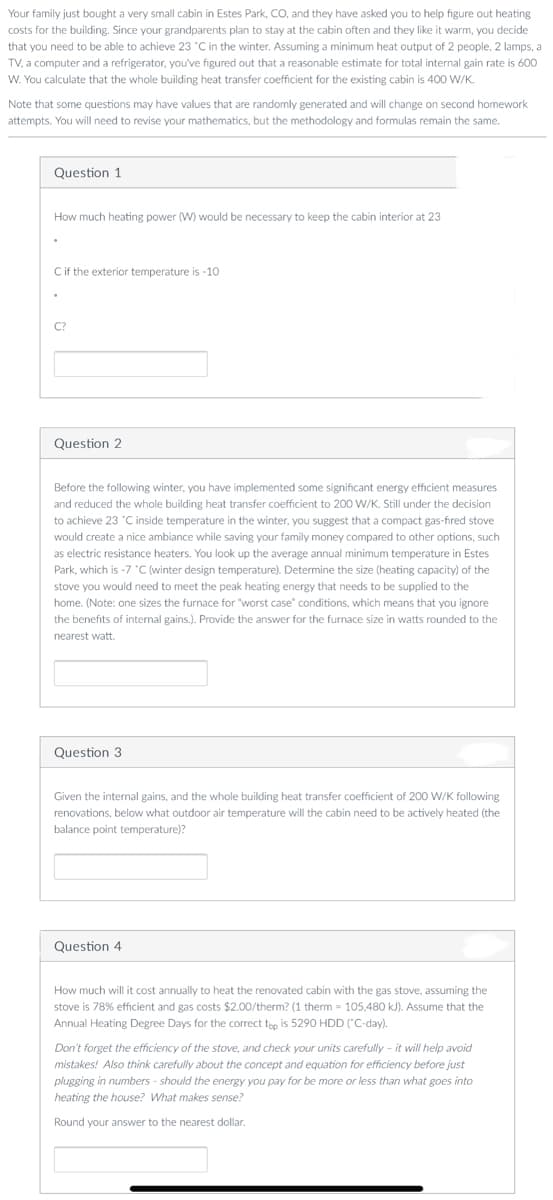Your family just bought a very small cabin in Estes Park, CO, and they have asked you to help figure out heating costs for the building, Since your grandparents plan to stay at the cabin often and they like it warm, you decide that you need to be able to achieve 23 "C in the winter. Assuming a minimum heat output of 2 people. 2 lamps, a TV, a computer and a refrigerator, you've figured out that a reasonable estimate for total internal gain rate is 600 W. You calculate that the whole building heat transfer coefficient for the existing cabin is 400 W/K. Note that some questions may have values that are randomly generated and will change on second homework attempts. You will need to revise your mathematics, but the methodology and formulas remain the same.
Your family just bought a very small cabin in Estes Park, CO, and they have asked you to help figure out heating costs for the building, Since your grandparents plan to stay at the cabin often and they like it warm, you decide that you need to be able to achieve 23 "C in the winter. Assuming a minimum heat output of 2 people. 2 lamps, a TV, a computer and a refrigerator, you've figured out that a reasonable estimate for total internal gain rate is 600 W. You calculate that the whole building heat transfer coefficient for the existing cabin is 400 W/K. Note that some questions may have values that are randomly generated and will change on second homework attempts. You will need to revise your mathematics, but the methodology and formulas remain the same.
Principles of Heat Transfer (Activate Learning with these NEW titles from Engineering!)
8th Edition
ISBN:9781305387102
Author:Kreith, Frank; Manglik, Raj M.
Publisher:Kreith, Frank; Manglik, Raj M.
Chapter11: Heat Transfer By Radiation
Section: Chapter Questions
Problem 11.1DP
Related questions
Question
Please and explain step by step, instructions given at top

Transcribed Image Text:Your family just bought a very small cabin in Estes Park, CO, and they have asked you to help figure out heating
costs for the building. Since your grandparents plan to stay at the cabin often and they like it warm, you decide
that you need to be able to achieve 23 "C in the winter. Assuming a minimum heat output of 2 people, 2 lamps, a
TV, a computer and a refrigerator, you've figured out that a reasonable estimate for total internal gain rate is 600
W. You calculate that the whole building heat transfer coefficient for the existing cabin is 400 W/K.
Note that some questions may have values that are randomly generated and will change on second homework
attempts. You will need to revise your mathematics, but the methodology and formulas remain the same.
Question 1
How much heating power (W) would be necessary to keep the cabin interior at 23
Cif the exterior temperature is -10
C?
Question 2
Before the following winter, you have implemented some significant energy efficient measures
and reduced the whole building heat transfer coefficient to 200 W/K. Still under the decision
to achieve 23 "C inside temperature in the winter, you suggest that a compact gas-fired stove
would create a nice ambiance while saving your family money compared to other options, such
as electric resistance heaters. You look up the average annual minimum temperature in Estes
Park, which is -7 "C (winter design temperature). Determine the size (heating capacity) of the
stove you would need to meet the peak heating energy that needs to be supplied to the
home. (Note: one sizes the furnace for "worst case" conditions, which means that you ignore
the benefits of internal gains.). Provide the answer for the furnace size in watts rounded to the
nearest watt.
Question 3
Given the internal gains, and the whole building heat transfer coefficient of 200 W/K following
renovations, below what outdoor air temperature will the cabin need to be actively heated (the
balance point temperature)?
Question 4
How much will it cost annually to heat the renovated cabin with the gas stove, assuming the
stove is 78% efficient and gas costs $2.00/therm? (1 therm = 105,480 kJ). Assume that the
Annual Heating Degree Days for the correct teo is 5290 HDD ("C-day).
Don't forget the efficiency of the stove, and check your units carefully - it will help avoid
mistakes! Also think carefully about the concept and equation for efficiency before just
plugging in numbers - should the energy you pay for be more or less than what goes into
heating the house? What makes sense?
Round your answer to the nearest dollar.
Expert Solution
This question has been solved!
Explore an expertly crafted, step-by-step solution for a thorough understanding of key concepts.
Step by step
Solved in 3 steps with 1 images

Knowledge Booster
Learn more about
Need a deep-dive on the concept behind this application? Look no further. Learn more about this topic, mechanical-engineering and related others by exploring similar questions and additional content below.Recommended textbooks for you

Principles of Heat Transfer (Activate Learning wi…
Mechanical Engineering
ISBN:
9781305387102
Author:
Kreith, Frank; Manglik, Raj M.
Publisher:
Cengage Learning

Refrigeration and Air Conditioning Technology (Mi…
Mechanical Engineering
ISBN:
9781305578296
Author:
John Tomczyk, Eugene Silberstein, Bill Whitman, Bill Johnson
Publisher:
Cengage Learning

Principles of Heat Transfer (Activate Learning wi…
Mechanical Engineering
ISBN:
9781305387102
Author:
Kreith, Frank; Manglik, Raj M.
Publisher:
Cengage Learning

Refrigeration and Air Conditioning Technology (Mi…
Mechanical Engineering
ISBN:
9781305578296
Author:
John Tomczyk, Eugene Silberstein, Bill Whitman, Bill Johnson
Publisher:
Cengage Learning